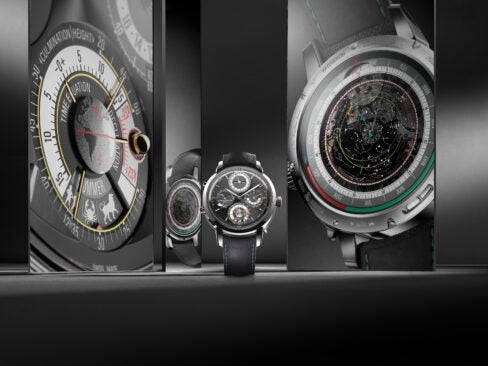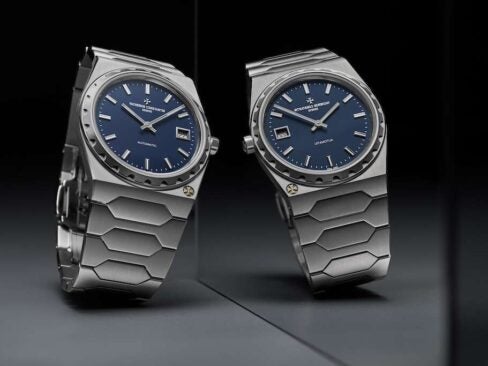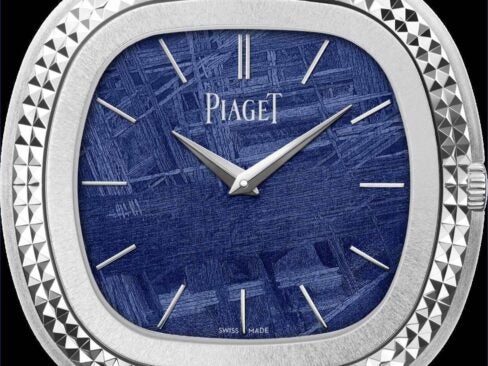
EXPLOSIVE AND MAGNETIC
An established master and a new concept introduce futuristic looks and technologies to horology.

CHRISTOPHE CLARET X-TREM-1
The shape of the X-TREM-1 is incredibly striking, but it is the unusual display that will probably grab the observer first. And, of course, upon scrutiny, the prospective owner may just fall into sheer disbelief that the time is actually revealed by the work of precise magnetic fields.
Magnetism, typically an archenemy of the mechanical watch, is as rare in luxury timepieces as a snowball is in the Sahara. The X-TREM-1 is very likely the first watch with no mechanical connection between its hands and its movement. Magnetism is utilized to move the hands, which are hollow balls 4mm in diameter moving along scales on either side of the tinted sapphire crystal that vaguely shows the gears and micro-machinery beneath. Their paths are predetermined by tubes of sapphire crystal that keep them in line. The ball-shaped “hands,” encased in sapphire crystal tubes displaying the minutes and hours, are controlled by magnets attached to extremely thin, very strong woven silk thread cables like those used in surgical procedures.
The base plate, crafted in titanium for lightness and inclined at the end for ergonomics, contains a rare mechanical pièce de résistance—a dual-wing movement.
Naturally, Christophe Claret tested the timepiece throughout an 18-month development phase to ensure that the magnetism does not influence the movement. Because the circulation of the magnetic field is strictly limited to the magnets, the filaments that support them and the steel spheres they maneuver, the balance spring remains unaffected.
The manually wound movement is clearly a Claret specialty: The base plate, crafted in titanium for lightness and inclined at the end for ergonomics, contains a rare mechanical pièce de résistance—a dual-wing movement. It is outfitted with twin spring barrels, one providing energy to each of the movement’s “wings.” One of these wings accommodates the gear train and one solely exists for the magnetic time indication.
This limited-edition wristwatch is housed in a truly majestic 40.8 by 56.8 by 15mm case. It is available in white gold, rose gold or naturally colored platinum, all combined with black PVD-coated grade 5 titanium (from $278,000). Mr. Claret is a highly experienced watchmaker, and insiders will know that he is behind many innovative products introduced to the market over the last two decades by other brands. He currently produces about 120 timepieces under his own name per year.

C 3H5N3O9 ZR012
There is a lot more behind the mystifying name ZR012 than the “ZR” standing for zirconium.
The numeral “012” does not denote the fact that there will only be 12 pieces of the ZR012 in zirconium, but rather the year in which they were manufactured. The next 12 pieces, which will be housed in red gold, are scheduled for release in 2013.
There is really no resemblance between this piece and any other on the market, so a casual observer would be hard-pressed to guess who has masterminded the project with the fairly unpronounceable name. The molecular formula in the moniker actually stands for “nitroglycerin.” And its makers are just as explosive: This is a joint project of the masterminds behind Ur werk and MB&F.
“A platform on which to conduct horological experiments” is how Manager Ian Skellern describes the boutique brand that does not plan to actively market or sell its timepieces. The idea of throwing together reactive ingredients such as zirconium, 328 mechanical watch parts and epitrochoids was first conceived of in 2008, when Maximilian Büsser (now of MB&F) and Felix Baumgartner (of Urwerk) spent an afternoon brainstorming after having previously joined forces on Harry Winston’s Opus 5.
Baumgartner and Urwerk co-founder Martin Frei devised a complication and display inspired by a Wankel engine—an obvious connection when looking at a photograph of the machine. The displays of the ZR012 do not move in the usual circular way that a wristwatch typically uses to show the time. Büsser, MB&F co-partner Serge Kriknoff and freelance designer Eric Giroud designed and produced the ZR012’s zirconium case, crafted in a hard material derived from the mineral zircon, which resembles titanium.
C 3H5N3O9’s “experiment” finds a great deal of its origins in the Wankel engine: The eccentric, rotating triangular elements are a dead giveaway for those in the know. The upper Revleaux polygon displays minutes by zeroing in on a small scale, while the lower Revleaux polygon guides the eye to a larger retrograde-style scale for the hours. The power reserve indicator of the 55 by 44mm hand-wound timepiece is located on the back.
“The aim is not to make a coherent brand, and we have no concrete ideas for the next models after the ZR012—which also means no constraints,” Skellern reveals. “Since we aren’t doing any publicity beyond our own website and Facebook page and not exhibiting at fairs or placing advertisements, if anyone wants to see it, they’ll have to look at my wrist.”
One of only 12 can be yours for $117,000, excluding shipping and taxes.









